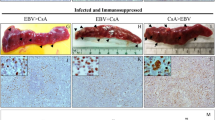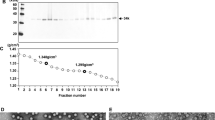Abstract
ONCORNAVIRUSES carry information for two distinct functions: virus multiplication and expression of oncogenicity1,2. The polycythaemia-inducing Friend virus (FVP) (as the Rauscher leukemia virus) infects and replicates in many types of cells cultured in vitro but as yet, no system for both infection in vitro and subsequent expression of oncongenic function has been described3,4. Morphological transformation of unidentified target cells occurs in vivo after infection of susceptible mice by FVP5. Transformation is characterised by the rapid and massive appearance of hyperbasophilic cells, so called Friend cells, only in the spleen red pulp, about 30–40 h after virus inoculation. Thereafter, an erythrocytic maturation starts and proceeds without influence of endogenous or exogenous erythropoietin, the physiological humoral factor for normal erythropoietic differentiation. The number of hyperbasophilic Friend cells and erythroblasts increases; these cells invade the organism and the animal dies 1–2 months after infection.
This is a preview of subscription content, access via your institution
Access options
Subscribe to this journal
Receive 51 print issues and online access
$199.00 per year
only $3.90 per issue
Buy this article
- Purchase on Springer Link
- Instant access to full article PDF
Prices may be subject to local taxes which are calculated during checkout
Similar content being viewed by others
References
Huebner, R. J., and Todaro, G. J., Proc. natn. Acad. Sci. U.S.A., 64, 1087–1094 (1969).
Martin, G. S., Nature, 227, 1021–1023 (1970).
Yoshikura, H., Hirokawa, Y., Yamada, M., and Sugano, H., Jap. J. med. Sci. Biol., 20, 225–236 (1967).
Wright, B. S., and Lasfargues, J. C., J. natn. Cancer Inst., 35, 319–327 (1965).
Tambourin, P., and Wendling, F., Nature new Biol., 234, 230–233 (1971).
Brommer, E. J. P., and Bentvelzen, P., in Unifying Concepts of Leukemia, 929–934 (S. Karger, Basel, 1973).
Chirigos, M. A., and Marsh, R. W., Antimicrob. Agents Chemoth., 6, 489–494 (1966).
Seidel, H. J., in Unifying Concepts of Leukemia, 935–942 (S. Karger, Basel, 1973).
Thomson, S., Proc. Soc. exp. Biol. Med., 130, 227–231 (1969).
Till, J. E., and McCulloch, E. A., Radiat. Res., 14, 213–222 (1961).
Trentin, J. J., Regulation of Hematopoiesis, 159–186 (Appleton–Century–Crofts, New York, 1970).
Schooley, J. C., J. cell. Physiol., 68, 249–262 (1966).
Curry, J. L., Trentin, J. J., and Wolf, N., J. exp. Med., 125, 703–720 (1967).
Lajtha, L. G., and Schofield, R., Differentiation, 2, 313–320 (1974).
Reissmann, K. R., and Udupa, K. B., Cell Tissue Kinet., 5, 481–489 (1972).
Smadja-Joffe, F., Jasmin, C., Malaise, E. P., and Bournoutian, C., Int. J. Cancer, 11, 300–313 (1973).
Author information
Authors and Affiliations
Rights and permissions
About this article
Cite this article
TAMBOURIN, P., WENDLING, F. Target cell for oncogenic action of polycythaemia-inducing Friend virus. Nature 256, 320–322 (1975). https://doi.org/10.1038/256320a0
Received:
Accepted:
Issue Date:
DOI: https://doi.org/10.1038/256320a0
This article is cited by
-
Hemopoietic stem cells and target cells in murine-virus-induced leukemias
Journal of Cancer Research and Clinical Oncology (1982)
-
Studies on the resistance of the C 57 Bl/6 mouse strain to the polycythemia-inducing strain of the Friend virus (FV-P)
Blut (1981)
-
Studies on the target cell for the friend virus (FV-P strain) using the CFU-E Technique
Blut (1978)
-
Analysis of erythropoeisis at the molecular level
Nature (1976)
Comments
By submitting a comment you agree to abide by our Terms and Community Guidelines. If you find something abusive or that does not comply with our terms or guidelines please flag it as inappropriate.



